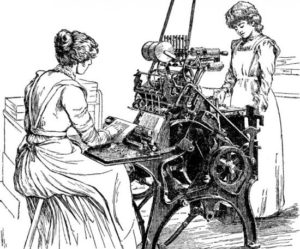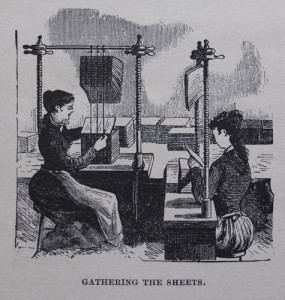 One of the by-products of the Industrial Revolution was a change in the status of women working outside the home. Working from home–doing piece-work in and around all the other jobs that were part of running a home, or being part of the “seasonal work force” for her husband’s business–had been part of women’s lot for centuries. But as industrialization moved manufacturing out of the home and the workshop and into the factories, women as well as men followed.
One of the by-products of the Industrial Revolution was a change in the status of women working outside the home. Working from home–doing piece-work in and around all the other jobs that were part of running a home, or being part of the “seasonal work force” for her husband’s business–had been part of women’s lot for centuries. But as industrialization moved manufacturing out of the home and the workshop and into the factories, women as well as men followed.
The women, American-born and immigrant, who flocked to the American factories could count on making significantly less than the men, regardless of whether they worked in the mills of New England or the sweatshops in New York City. Bookbinding was one of the newly industrialized businesses that was relatively well-paid. In 1851, Horace Greeley of the NY Tribune estimated that a working-class family of five needed $10.37 a week to live on. (1) But most (male) factory workers didn’t make that. The average a man in a factory job could earn at this time was about $6 a week–roughly 2/3 of Greeley’s suggested household income. Women (and often their children) had to make up the balance.
Regardless of gender, work in a factory unrelenting: six days a week, 12-13 hours a day, with perhaps two half-hour breaks for meals. There were four more-or-less universally celebrated holidays: Fourth of July, Thanksgiving, Christmas, and “Fast Day.” For this a woman working in the textile mills might make $1-2 a week. Women working in the bookbinderies did better. How much better depends on when you ask, as well as whom. In 1835 (a year notable for strikes across the US, in many different industries) Philadelphia bookbinders not only moved to a $3/week minimum wage for women, but reduced the work-day to 10 hours. (2) But ten years later in New York City, the Tribune reported that there were between 2,500-3,000 “girls” engaged in the “respectable binderies” at wages ranging from $1.50 to $6 a week (the average being about $2.50 a week), depending on their speed and skill. (3) As a rule, bookbinding was a better industry for women than tailoring or the mills, but better, too, is a relative term.
There were many ways an unscrupulous employer could take advantage of the women working in the binderies. One was to establish an “apprenticeship” period for new hires–not an uncommon or unreasonable thing. But in some binderies new workers were told they must train for six weeks without pay. Then, at the end of the period, they were fired to make way for another group of unpaid “apprentices.” (4) Even when there was no attempt to scam the workers, women’s training was usually for a few weeks only; whereas men commonly did apprenticeships of four years or so. This meant that women were not trained for, and therefore were unlikely to hold, the higher paying skilled jobs.
Payment by the piece, which was common in factories and binderies, was another way for binders to keep their costs down. For example, for folding single octavo sheets (a signature) a worker might get $0.02 per hundred; for folding double octavo sheets, $0.035/hundred; for folding duodecimo sheets, $0.0525/hundred. Signature stitching, in the days before the advent of mechanical book stitchers, would bring $0.025 per hundred. (5) The by-the-piece payment system rewarded the fastest workers, although not always the best. Further, as one woman told an investigator in 1911, “I worked very hard, but I tried to keep a schedule, because if one girl turns out too much in a day, they’re apt to cut the rates.” (6)
Social stratification could also work to keep women’s wages low. In the Report on the Condition of Women and Child Wage-earners in the United States, published in 1911, class snobbery was listed as one of the obstacles to unionizing. “Bookbinders often consider themselves member of a “profession,” but look upon the women who feed the presses as “working girls.” It was hard to get the “professional” women to identify themselves with the “working” women, let alone join an organization with such a mixed membership.(7) Gradually, the need to come together to negotiate with the bindery owners overcame stratification.
By 1913, women bookbinders outnumbered men substantially: 12,960 men worked in binderies vs 18,449 women. By that time the desired wage for a trained woman was $10 a week, with an 8-hour day and overtime pay. (8) A $520-a-year wage in 1913 fell well below the average individual income of $800; women’s income was still meant to be a supplement to a man’s.
As part of Women’s History Month, the American Bookbinders Museum presents “Women in Bookbinding,” an exhibition featuring books and ephemera from the Museum’s collections.
- http://www.digitalhistory.uh.edu/disp_textbook.cfm?smtID=2&psid=3521
- US Bureau of Labor: Report on the Condition of Women and Child Wage-earners in the United States, 1911, page 210.
- Ibid.
- Ibid, p. 211.
- Ibid, p. 210.
- Diner, Steven: A Very Different Age: Americans of the Progressive Era. New York: Farrar, Straus and Giroux, 1998. Page 59.
- US Bureau of Labor, op cit. p. 144.
- Van Kleeck, Mary, 1883-. Women In the Bookbinding Trade. New York: Survey Associates, inc, 1913. PP 222-223.
- http://www.moneychoice.org/then-vs-now/


